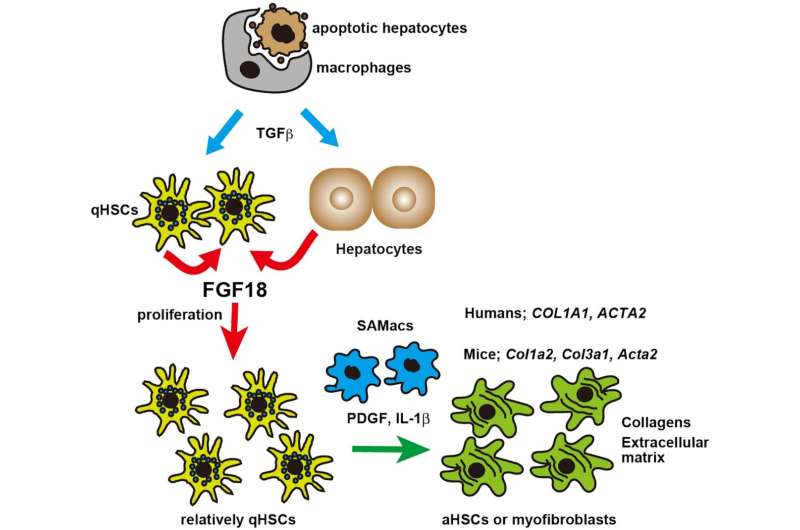This article has been reviewed according to Science X's editorial process and policies. Editors have highlighted the following attributes while ensuring the content's credibility:
fact-checked
peer-reviewed publication
proofread
New study unveils the novel factor FGF18 as a pivotal driver of liver fibrosis

Liver fibrosis is associated with various liver injuries, including viral infection, inflammation, excess alcohol consumption, and metabolic dysfunction. More importantly, the number of patients with metabolic dysfunction-associated steatohepatitis (MASH) is increasing worldwide.
Fibrosis is a critical determinant of the prognosis of patients with liver diseases, but no antifibrotic drugs are currently approved for the treatment of liver fibrosis. Therefore, clarifying molecular mechanisms and identifying druggable targets are necessary to fulfill the unmet medical needs of liver fibrosis.
Hepatic stellate cells (HSCs), which are resident cells in the liver, store vitamin A and are quiescent under normal conditions. Once activated in response to liver injury, HSCs differentiate into myofibroblasts and produce collagen and extracellular matrix proteins, resulting in tissue remodeling and fibrosis. Therefore, the molecules controlling the proliferation and/or activation of HSCs are attractive therapeutic targets.
In a new study published in Nature Communications, a Japanese research team reported that fibroblast growth factor 18 (FGF18) was a key inducer of HSC proliferation and liver fibrosis. Using various conditional gene knockout mice and experimental liver injury models, the team identified FGF18 as a growth factor that was specifically upregulated in fibrotic liver. Under normal conditions, hepatocytes and HSCs very weakly expressed FGF18, but FGF18 was dramatically elevated under fibrotic conditions.
Hepatocyte-specific deletion of Fgf18 ameliorated liver fibrosis under pathological conditions, and hepatocyte-specific overexpression of Fgf18 induced liver fibrosis. Single-cell RNA sequencing revealed that the number of HSCs was increased in the livers of mice overexpressing Fgf18 in hepatocytes.
Moreover, in vitro experiments showed that FGF18 stimulated the proliferation of HSCs without upregulating the expression of profibrotic genes, such as collagens or Acta2. When combined with other factors that activate HSCs and induce profibrotic gene expression, FGF18 promotes liver fibrosis through the proliferation of HSCs. "Our results indicate that FGF18 may be a therapeutic target to treat and prevent liver fibrosis in human," stated Professor Hiroyasu Nakano, the corresponding author of this study at Toho University, Faculty of Medicine.
In various experimental animal models of liver fibrosis, prior induction of hepatic inflammation is necessary. From the view of drug screening, it is difficult to determine whether the drug affects inflammation or fibrotic processes in these cases. In contrast, the hepatocyte-specific FGF18-overexpressing mice used in this study exhibited liver fibrosis without prior induction of hepatic inflammation.
"Our mice can be a new animal model to directly address the fibrotic process to screen anti-fibrotic drugs in the liver," stated Dr. Yuichi Tsuchiya, the first author of this study at Toho University Faculty of Pharmaceutical Sciences.
More information: Yuichi Tsuchiya et al, Fibroblast growth factor 18 stimulates the proliferation of hepatic stellate cells, thereby inducing liver fibrosis, Nature Communications (2023). DOI: 10.1038/s41467-023-42058-z





















